Eclectus Parrot - Eclectus roratus - Least Concern
The eclectus parrot (Eclectus roratus) is a parrot native to the Solomon Islands, Sumba, New Guinea and nearby islands, northeastern Australia, and the Maluku Islands (Moluccas). It is unusual in the parrot family for its extreme sexual dimorphism of the colours of the plumage; the male having a mostly bright emerald green plumage and the female a mostly bright red and purple/blue plumage.
Large populations of this parrot remain, and they are sometimes considered pests for eating fruit off of trees. Some populations restricted to relatively small islands are comparably rare. Their bright feathers are also used by native tribespeople in New Guinea as decorations.
There are 9 subspecies, and three dubious, or hypothetical subspecies. One extinct species, the Oceanic Eclectus Parrot, was discovered in the fossil record in the late 1980's.
The eclectus parrot is unusual in the parrot family for its marked visible light sexual dimorphism in the colors of the plumage. A stocky short-tailed parrot, it measures around 35 cm (14 in) in length. The male is mostly bright green with a yellow-tinge on the head. It has blue primaries, and red flanks and underwing coverts. Its tail is edged with a narrow band of creamy yellow, and is dark grey edged with creamy yellow underneath, and the tail feathers are green centrally and more blue as they get towards the edges. The grand eclectus female is mostly bright red with a darker hue on the back and wings. The mantle and underwing coverts darken to a more purple in color, and the wing is edged with a mauve-blue. The tail is edged with yellowish-orange above, and is more orange tipped with yellow underneath. The upper mandible of the adult male is orange at the base fading to a yellow towards the tip, and the lower mandible is black. The beak of the adult female is all black. Adults have yellow to orange irises and juveniles have dark brown to black irises. The upper mandible of both male and female juveniles are brown at the base fading to yellow towards the biting edges and the tip.
Some amazing color mutations are starting to appear in the Eclectus parrot. More pictures at the bottom of the page.
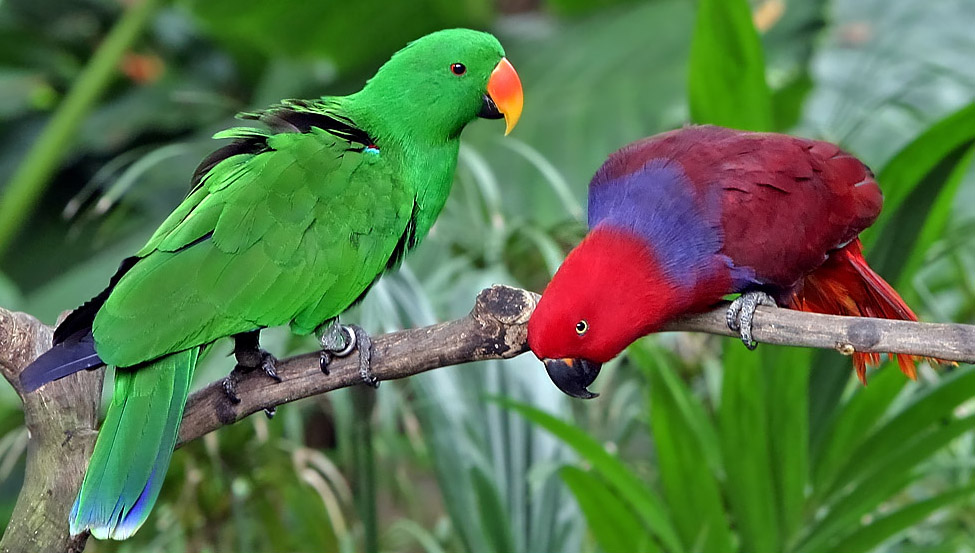
Subspecies
Nine subspecies of eclectus parrots are known, although the species as a whole needs reviewing. Access to some regions where the species occurs is difficult due to geographical or political reasons, hence field observations have been limited. Furthermore, many skins collected in the early part of the 19th century have deteriorated in some museums. However, most eclectus skins in US museums are in good condition. In captivity in the U.S., some of the most common subspecies are the Solomon Island, Vosmaer's, and the New Guinea red-sided.
Dubious subspecies
Nine subspecies of eclectus parrots are known, although the species as a whole needs reviewing. Access to some regions where the species occurs is difficult due to geographical or political reasons, hence field observations have been limited. Furthermore, many skins collected in the early part of the 19th century have deteriorated in some museums. However, most eclectus skins in US museums are in good condition. In captivity in the U.S., some of the most common subspecies are the Solomon Island, Vosmaer's, and the New Guinea red-sided.
- Eclectus roratus roratus, known as the grand eclectus, is found on Buru, Seram, Ambon, Saparua, and Haruku in the southern Maluku Islands. The subspecies begins intergrading with race vosmaeri on Seram.
- Eclectus roratus vosmaeri, known as Vosmaer's eclectus or Vos eclectus, was originally described by Rothschild. Larger in size than the nominate subspecies with more yellow in the plumage, it is found on islands in the North Maluku province. The male has more yellow-toned plumage on the head and neck. The tail is bluer and has a small pale lemon yellow border. The female is a brighter red on the head, back, and wings. Her undertail coverts are yellow and at least an inch of the tail is bright pure yellow.
- Eclectus roratus cornelia, known as the Sumba Island eclectus parrot, is restricted to Sumba island in the Lesser Sunda Islands. Also larger than the nominate, the male is a paler shade of green overall and has a bluer tail. The female has an all red plumage, except for the primaries which are a dark royal blue. It was described by Bonaparte.
- Eclectus roratus riedeli, known as the Tanimbar Islands eclectus parrot, is found on the Tanimbar Islands. It is smaller than the nominate race. The male has a more bluish tinge to its green cheeks and neck, and its tail is edged with a broad band of yellow. The female has an all red plumage, except for royal blue primaries and a broad band of yellow to edge the tail.
- Eclectus roratus polychloros, known as the New Guinea red-sided eclectus parrot, was named by Scopoli. Larger than the nominate race, the green plumage of the male only has a slight yellow tinge and the tail is tipped with a half-inch yellow band. The central tail feathers are green and lateral ones blue and green. It is widely distributed from Kai Islands and western islands of the West Papua province in the west, across the island of New Guinea to the Trobriands, D'Entrecasteaux Islands, and Louisiade Archipelago to the east. It has also been introduced to the Goram Islands, Indonesia.
- Eclectus roratus macgillivrayi, known as the Australian eclectus parrot, was named by Gregory Mathews in 1912. It is found on the tip of Cape York Peninsula. It resembles E. r. polychloros, but is larger overall.
- Eclectus roratus solomonensis, known as the Solomon Island eclectus parrot, resembles E. r. polychloros, but is smaller overall with smaller bills and paler orange in the upper mandible of the male. The green of the male has a more yellow tint, quite similar to the green of E. r. vosmaeri.
Dubious subspecies
- Aru Island eclectus parrot (Eclectus roratus aruensis) – While some believe this bird is doubtfully valid from E. r. polychloros, others believe it is a distinct subspecies, as the rich yellow on the tail tip of the male often is infused with pink, orange, or bright red. At this point, no male eclectus in other subspecies has been described with this type of tail feather coloring. The Aru Island eclectus specimens are also larger than E. r. polychloros, often weighing 100 grams or more than E. r. polychloros.
- Biak Island eclectus parrot (Eclectus roratus biaki) – While some believe the Biak eclectus is doubtfully valid from E. r. polychloros, others believe it is a distinct subspecies due to the size difference, vocalization, and behavior differences.
- Westerman's eclectus parrot (Eclectus roratus westermani) – Many of the museum specimens have clipped wings and clipped tails, and no uniformity is seen in the coloration of the female specimens, indicating the likelihood of these specimens being crossbred aviary birds. However, Joseph Forshaw doubted it was an aberration, and its status remains unclear. If it ever existed, it is extinct today.
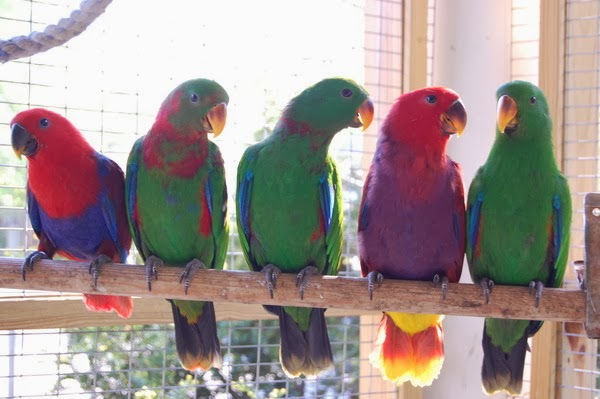
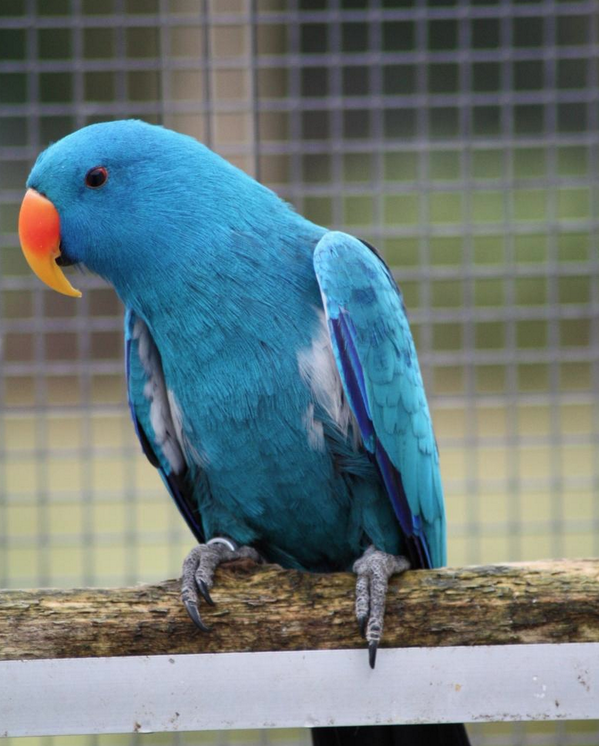
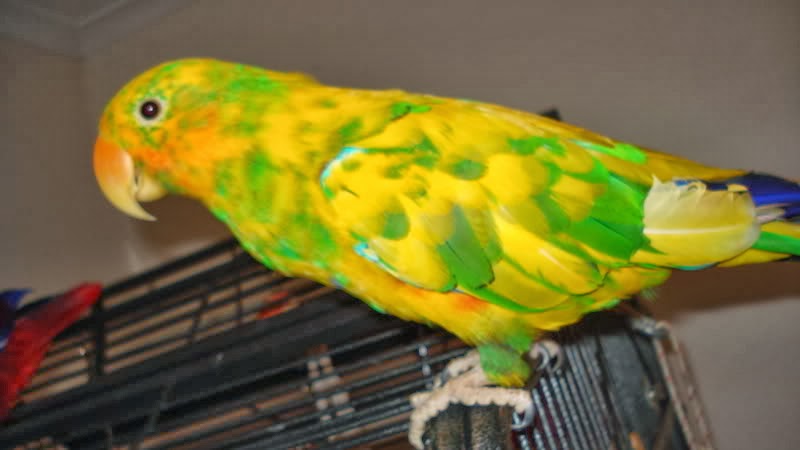
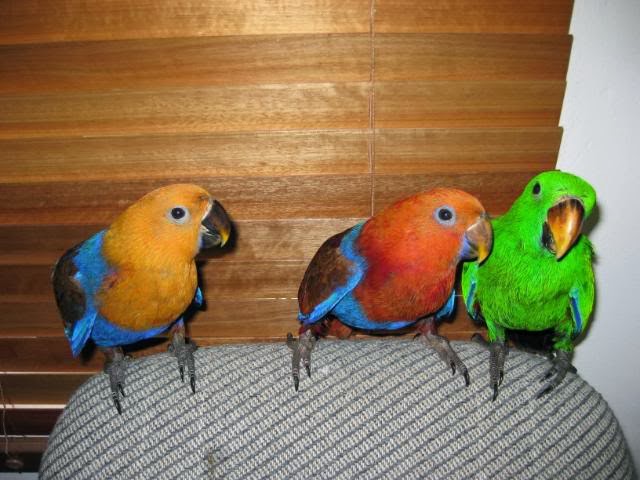
Psittaciformes, The Parrot Index, a part of Phoenix Feathers © 2016 - 2023
Page last updated: 12/24/23
Phoenix Feathers

